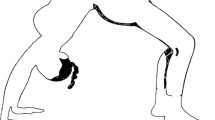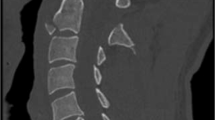Abstract
Study design:
Case series.
Objective:
To present three cases of spinal cord injuries associated with skimboarding and to suggest aspects of the sport that may be associated with spinal cord injury.
Setting:
Shepherd Center, Atlanta, GA, USA. Spinal cord injury rehabilitation facility.
Methods:
Three males, aged 17–23 years, sustained cervical spine fractures resulting in tetraplegia after skimboarding accidents.
Results:
The patients admitted from Florida hospitals presented with tetraplegia resulting from both incomplete and complete spinal cord injuries. The ASIA Impairment Scale (AIS) neurologic levels ranged from C3 to C5. All were injured by being thrown from the skimboard riding into the waves in shallow water. All patients required surgical stabilization and inpatient rehabilitation.
Conclusions:
Previous studies on skimboarding have demonstrated the risk of extremity fractures and soft tissue injuries. Spinal cord injury should be considered an additional risk associated with skimboarding, particularly as the sport has grown in popularity and become more ‘extreme’ in the maneuvers performed. Increased education and awareness about the potential risk of spinal cord injury are essential.
Similar content being viewed by others
Introduction
Skimboarding is growing in popularity. The water sport has also increased in technical difficulty as the types of maneuvers performed in skimboarding have become more ‘extreme.’ Although previous studies have demonstrated an association between skimboarding and lower extremity fractures,1, 2, 3, 4 none has reported spinal cord injuries. The patients in the following case profiles suggest that spinal cord injury may be a growing risk.
Case series
Case 1
A 17–year-old male was admitted with a motor incomplete (AIS C) cervical (C4–C5) spinal cord injury after a skimboarding accident. The patient, who was an advanced, competitive skimboarder (shown in competition in Figures 1 and 2), reported that a wave propelled him into the air; he then fell into the water and hit his head on the ocean floor. Imaging studies revealed a C4–C5 fracture dislocation (Figure 3) and he was surgically stabilized. Upon admission to the rehabilitation unit, the patient presented with quadriplegia typical of a motor incomplete cervical spinal cord injury, and was unable to walk. At discharge, he was ambulating independently with bilateral crutches.
Case 2
A 23-year-old male was admitted from the same hospital as case 1. He was classified as a sensory incomplete (AIS B) C4 spinal cord injury. The patient stated that a large wave flipped his skimboard, pressing him into the ocean floor. His imaging revealed a C5 fracture dislocation. Surgical intervention included anterior diskectomy, corpectomy and C4–C6 fusion. At rehabilitation admission, the patient presented with lower extremity muscle paralysis typical of a C4 AIS B spinal cord injury. At discharge, he demonstrated C5 motor skills bilaterally, although his classification level remained C4 AIS B.
Case 3
A 19-year-old male was admitted with a C3–C4 AIS A spinal cord injury. He reportedly fell off of his skimboard, landed head first in shallow water and experienced immediate paralysis. Imaging revealed C3 and C4 fractures. He was surgically stabilized and has remained ventilator dependent.
Discussion
Skimboarding is both a recreational and competitive sport and there are two distinct styles of boarding. Both begin with the skimboarder running and jumping on the moving board as it hydroplanes in the surf (Figure 2). The skimboarder can ride along the beach in the receding water—as recreational riders commonly do—or ride away from the beach into the oncoming waves (Figure 3a). When heading into the waves, two maneuvers are common. The typical maneuver is to make a 180° turn (or ‘Wrap’) and ride the wave back to shore (Figure 4). A more technically demanding maneuver is to incorporate aerial tricks, such as jumps, flips and twists, into the Wrap (Figures 3b, c and 5). Even among recreational boarders, this extreme style is gaining in popularity as skimboarding has grown into a competitive sport.
Previous studies have documented that upper and lower extremity fractures are most commonly associated with skimboarding. Williams et al.1 reported on cases seen in a fracture clinic with skimboarding injuries over a 5-month period (May to September 2003). Ten patients (eight males) were seen, eight with lower limb fractures (tibia, ankle, mid-foot) and two with wrist fractures.
Donnelly et al.2 reported two cases of ‘skimboarder's toe’—hyperdorsiflexion of the metatarsophalangeal joint—that occurs when the skimboard slips out from under the rider. Swischuk3 reported on a scapular fracture resulting from a fall in shallow water. In the most extensive study to date, Merriman et al.4 reviewed records from emergency department visits over a 52-month period and identified 79 patients with skimboard-related injuries. Fractures were the most common injury (73%) with about two-thirds of these injuries in the lower extremities. Soft-tissue injuries (19%) and lacerations (8%) were also reported, with most of these (86%) also occurring in the lower extremities.
The skills and techniques used in skimboarding are similar to those required for surfing, skateboarding and snowboarding. There have been documented incidents of spinal cord injuries associated with skiing, snowboarding, skateboarding and trampoline activities.5 As skimboarding occurs in shallow water—essentially on land—these sports may provide a good basis for comparison of the risk of neck and spinal injury. Moreover, as skimboarding has become more extreme in the tricks and maneuvers performed, the risk of significant injury from landing head first in shallow water is increased. Being thrown from a skimboard at high speed and height may pose the same risk as unintentionally diving into shallow water.
The cases in this series are the first instances of spinal cord injuries resulting from skimboard accidents at the reporting hospital, a major tertiary care center for spinal cord injury since 1975. As the sport continues to grow and the complexity of aerial maneuvers increases, it is likely that more spinal cord injuries will occur. At present, there is insufficient evidence from which to estimate the future prevalence of skimboard-related spinal cord injuries. However, some insight may be obtained from research into diving-related injuries. Jackson et al.6 reported on the demographics of traumatic spinal cord injuries, using data collected by the Model Spinal Cord Injury Systems facilities over a 30-year period (1973–2003). Of 30 501 reported cases, 6.6% were due to diving-related injuries. The authors note that the prevalence of diving-related injuries has trended down over the 30-year period (from 9.5% of cases in 1973–79 to 3.9% of cases in 2000–03). They attribute this decrease to numerous prevention efforts in recent years, such as the Feet First First Time public awareness program. Unfortunately, the growing popularity of extreme skimboarding may negate the effects of these prevention efforts unless similar prevention efforts are undertaken.
Conclusion
Currently, the risk of strains, sprains and fractures are conveyed on skimboarding websites and publications. There is no mention of potentially life-threatening injuries, such as spinal cord injury, that may ensue from the sport. The risk of spinal fracture and cord injury is likely to increase as skimboarders continue to push the envelope of more extreme aerial maneuvers. Medical professionals and skimboarding enthusiasts (who are usually teenagers) and their families should be made aware of this risk. Increased education about the potential risk of spinal cord injury is essential.
References
Williams MR, Moulter RJ, Fern ED . Skimboarding: a new danger in the surf? Emerg Med J 2006; 23: 137.
Donnelly LF, Betts JB, Fricke BL . Skimboarder's toe: findings on high-field MRI. AJR 2005; 184: 1481–1485.
Swischuk LE . Skimboarding: fall on shoulder-pain. Pediatr Emerg Care 2008; 24: 190–192.
Merriman D, Carmichael K, Battle SC . Skimboard injuries. J Trauma 2008; 65: 487–490.
Cooper MT, McGee K, Anderson G . Epidemiology of athletic head and neck injuries. Clinics in Sports Medicine 2003; 22: 427–443.
Jackson AB, Dijkers M, DeVivo MJ, Poczatek RB . A demographic profile of new traumatic spinal cord injuries: change and stability over 30 years. Arch Phys Med Rehabil 2004; 85: 1740–1748.
Author information
Authors and Affiliations
Corresponding author
Rights and permissions
About this article
Cite this article
Collier, T., Jones, M. & Murray, H. Skimboarding: a new cause of water sport spinal cord injury. Spinal Cord 48, 349–351 (2010). https://doi.org/10.1038/sc.2009.122
Received:
Revised:
Accepted:
Published:
Issue Date:
DOI: https://doi.org/10.1038/sc.2009.122








